| Where: | Whitby, North Yorkshire on riverbank next to Church Street |
| When: | Ascension Eve (always a Wednesday and variable in date depending on Easter) |
| Time: | 9am. |
In a unique custom, the Penny Hedge or Horngarth at Whitby is planted in the estuary of the Upper Harbour – it must be completed by 9am on Rogation Wednesday, also known as Ascension Eve, and must be strong enough to withstand three tides. The hedge is woven from hazel and willow and legend has it that it is planted in penance (the Penny name comes from penance or from the penny knife used to cut the stems) in memory of a long ago episode in which the local hermit was beaten to death by huntsmen after he protected their wild-boar prey – the huntsmen received pardon for their crime if they agreed to build a hedge every year and their descendants still do so today. It’s more likely that the real origin lies in manorial boundary maintaining customs (see Comments below) but it is certain that the planting dates back to the mid twelfth century so it’s not too surprising that the facts have been obscured by the mists of time. It’s a simple ceremony with two men building the hedge – don’t expect any fuss or festivities except for horn blowing and shouts of “Out on Ye!” when they finish .
Helpful Hints
It takes place on the east bank of the River Esk just over the railings on Church Street and construction begins at around 20 to 9- look out for the monument to the custom on the pavement then you’ve found the right spot. Sometimes the previous years hedge is still standing as in 2014 (for a moment when we first spotted it I thought we must have got the time wrong and missed the ceremony!).
In 2025 it should be on Wednesday 28th May.
It often features on this Facebook page: https://www.facebook.com/groups/129958666651
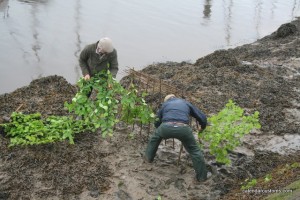
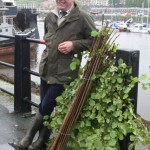
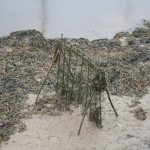
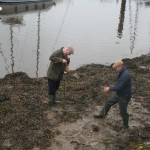
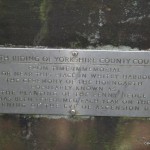
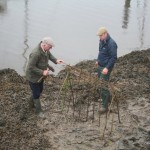
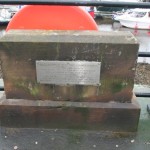
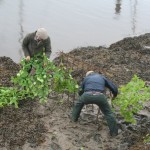
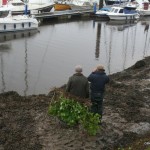
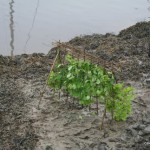
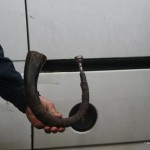
This event has nothing to do with the murder of a Monk. It is a fictitious 16th C tale dreamed up by papist players of interludes. the earliest record was found at a Catholic dwelling near Thirsk some 50 miles from Whitby dated 1627
A note in the Chartulery of Whitby Abbey identifies the procedure as the Horngarth. The Horngarth was a feudal ceremony known as forinsec service, imposed by the King. It was required from all freeholders of land and bestowed to the abbot the rights of wardship & marriage. The Horngarth was originally a large fence surrounding arable land adjacent to the Monastery being commuted to a token event about 1340.
The tales surrounding the origins of many of our long-standing customs can be taken with a hefty pinch of salt! I can think of several others just in the North of England (the Portland Wheelbarrow Race, Haxey Hood and Durham Cathedral’s legend of the plummeting chorister all spring to mind) but I suppose the myths become a part of the custom, and a good tale is worth repeating even if it’s fictitious. However, it’s always good to know the truth even if it’s not as colourful as the legends. Thanks for sharing – it’s a remarkable survival given that it became a token event so long ago.
Best wishes,
Averil
I agree that lots of people find the tales interesting and wish that they were true. Early Whitby historians: Charlton in his History of Whitby !779: Young 1815 and Atkinson in his Memorials of Old Whitby have condemned the legend as complete fiction. I noticed that Charlton suggested that surnames ending son evolved nearly 200 years after the date of 1159 attached to the legend. the name Allatson occurs in the legend and is a common factor in references until 1755 when their land was sold to an Isaac Herbert. Allatson is derived from the son the Allot, an allot being an official who allotted land in the acregarths which were large agricultural fields belonging to various manors.
In 1301 Edward I levied a “Poll Tax”, Robert son of Allot lived at Ruswarp near Whitby. Further poll taxes were levied in 1327 and 1333 by this time Robert had evolved to become Robert Allatson. There is more !
Bill
Do tell! Sometimes real people’s names get associated with legends that they personally had no connection with in life, because tales always sound more convincing with names that could be real….
Averil
William Lyth
Allatson continued :- Lionel Charlton in the preface of his ‘History of Whitby’ notes that towards the end of the 14th C John Allatson aka Elotson was a business man in Fylingdales trading with the monks. The Monastery accounts showed Allatson selling seven barrels of pitch, coils of rope or twine and delivering loads of peat and sawn wood for the Abbey fires. He is on record as buying a pig from the monks for one shilling. Charlton goes on to state that he was of the opinion that the Allatson’s had no free hold there. This begs the question of why he needed to make such a statement when he must have been party to the event of the last of the Allatson’s, selling his freehold in the 18th C
These accounts have been reported as lost. That they existed is confirmed in the will of John Elotson dated 1404. John owned property in Kirkgate and lived next door to John Pedilton, now Pedlington who gave his name to Pedlington field, the large area adjacent to the Abbey lying south of Green Lane.
John left numerous bequests included were the Abbot, the convent, the two chaplains, (Fylingdales was a chapelry of Whitby) and the fabric of Whitby bridge. Four pounds of wax was to be burnt around his body during his funeral.
The next reference to Allatson is in the form of a memorandum noted on a fly sheet at the front of what is known locally as the Abbot’s Book. Canon JC Atkinson who spent 40 years in the Moorland Parish of Danby considered it to be of little reliability. Richard Cholmley purchased the Manor of Whitby after the dissolution, he was a stranger to the area and would have needed a memorandum to remember this feudal due which the Abbot had continued to impose on freehold land. The participants at this time being named as Allatson, Conyers, Strangwayes and Elrington.
Richard Cholmley purchased land in Fylingdales in 1563 from Queen Elizabeth I at which time two Allatson’s held arable land. Edward Allatson paid a yearly rent of eight shillings and eight pence for two oxgangs of land (approx 26 acres) for land in Fyling.
Robert Allatson however only paid free revenue of one shilling and six pence, for a tenement and two oxgangs of land in Thorpe. (Thorpe is a hamlet in Fylingdales)
More to follow :- Bill
As far as I am aware, none of the commentators on the Ceremony of the Horngarth or Penny Hedge Ceremony have referenced it to wider Indo-European traditions, probably because most of those commentators were clerics who would not wish to explore the probable pagan origins of the ceremony c.f. Gregor Lamb’s ‘Carnival of Animals’.
Hi Avril, As a tour of Yorkshire I was going to take in Whitby Penny Hedge but obviously had to cancel. I would be interested to know if it may still go ahead being a very low key and small event as two men actually erect the hedge. On ascension day I had planned the 3 yearly Tower of London bounds which I was going to combine with Harwich Ketches. At least the former should be in 2021. This May doing all the events on a “virtual” basis, going through my archives of previous visits & U tube etc as come around. Looking ahead to July on local news it was announced Swan Upping is cancelled. Honiton Charter Day is also off and I would imagine Hot pennies is as well. Regards Hugh
Hi Hugh,
Nice to hear from you! I wouldn’t be surprised if the actual custom goes ahead without an audience, as it’s on such a small scale but I’m not certain! I’ve read that the battle at the beating of the bounds in London will happen next year since it’s off this time, so with a bit of luck it won’t be a wait until the next 3-year cycle in 2023. Sadly I think this summer will be a total write-off as even if things improve people won’t have any time to prepare or raise funds to stage events, and it seem that the virus is far from under control. Keep me posted if you hear news of anything else – I’m looking forward to getting out and about again whenever that might be possible!!
Best wishes,
Averil